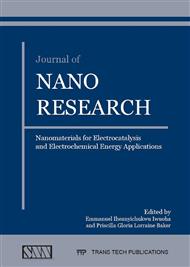p.134
p.142
p.158
p.196
p.208
p.229
p.252
p.265
p.281
Cytochrome P450-3A4/Copper-Poly(Propylene Imine)-Polypyrrole Star Co-Polymer Nanobiosensor System for Delavirdine - A Non-Nucleoside Reverse Transcriptase Inhibitor HIV Drug
Abstract:
HIV and AIDS are among the world’s pandemics that pose serious concern to almost every individual in the world. With the current level of availability of anti-retroviral (ARV) drugs and the ease of accessibility of treatment in many countries such as South Africa, the disease can be controlled by suppressing the viral load of an infected individual. These anti HIV drugs such as delavirdine are metabolised by enzymes which are found in the liver microsomes, particularly those of the cytochrome P450 family. Due to the fact that the metabolic rate of a patient determines the effect of the drug, the drug could either have a beneficial or an adverse effect once it is administered. It is therefore imperative that the metabolic profile of a patient is determined to ensure proper dosing of the ARV drugs. In this study a nanobiosensor system was devised and used for the determination of the metabolism of delavirdine (DLV), a non-nucleoside reverse transcriptase inhibitor (NNRTI) ARV drug. The nanobiosensor was prepared by the entrapment of the isoenzyme CYP3A4 into a pre-formed electro active carrier matrice consisting of a dendrimeric copper generation-2 poly(propylene imine)-co-polypyrrole star copolymer (Cu(G2PPI)-co-PPy). The metallo-dendrimer was used as a host for the enzyme and provided the necessary bio-compatible environment that allowed the direct transfer of electrons between the enzyme’s active centres and platinum electrode surface. (Cu(G2PPI)-co-PPy) was prepared by the incorporation of the copper metal into the G2PPI and the electropolymerization of pyrrole onto the Cu(G2PPI). The incorporation of Cu into G2PPI was determined by Fourier transform infrared (FTIR) spectroscopy which did not show the presence of the Cu but showed an increase in the intensities of the peaks after the incorporation. The surface morphology of Cu(G2PPI-2Py) was confirmed by the use of high resolution scanning electron microscopy (HRSEM) which showed a difference in the surface morphology of the dendrimer moiety with the addition of the copper metal. The HRSEM images after Cu incorporation resulted in the change from rough surface to smooth surface with open cavities which were essential for the entrapment of the biological systems (CYP3A4). The energy band gap of (Cu(G2PPI)-co-PPy) were determined to be 3.85 eV, signifying that the copolymer is characteristic of a biocompatible semiconductive platform for applications in biosensors. The star copolymer (Cu(G2PPI)-co-PPy) was characterized using cyclic voltammetry where it was confirmed that the material was electroactive and conducting due to electron movement along the polymer chain. A diffusion co-efficient (Do) value of 8.64 x 10-5 cm2/s was determined for the material indicating a slow electron transfer kinetics within the diffusion layer. The resultant nanobiosensor parameters include a dynamic linear range (DLR) of 0.01-0.06 nM, a limit of detection (LOD) of 0.025 nM and a sensitivity value of 0.379 μA/nM.
Info:
Periodical:
Pages:
265-280
Citation:
Online since:
November 2016
Price:
Сopyright:
© 2016 Trans Tech Publications Ltd. All Rights Reserved
Share:
Citation:


